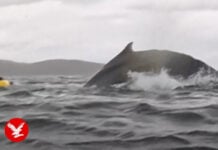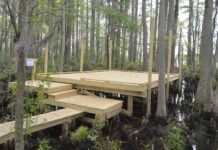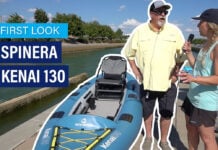Sally Wallick, a music teacher from Kelowna, B.C., was out enjoying the sunshine on Okanagan Lake when she noticed a fellow kayaker had capsized and become stranded.
Despite Kelowna’s warm spring temperatures, Okanagan Lake can still reach frigid low temperatures of around 9 degrees celsius. Wallick paddled over to the man and quickly learned that he had been capsized and in the water for at least 45 minutes. As she approached, she realized his lips were blue. With hypothermia top of mind, she knew she had to act fast.
Wallick urged the man to grab onto the back of her kayak so that she could paddle him to shore. After some trial and error, she instructed him to move to the front of her boat and to “try to kick” so that he would stay as warm as possible.
The stranded paddler seemed unwilling to leave his kayak and belongings behind. “You’re really cold. Leave the kayak. We’ll find it I promise,” said Wallick in the video. She reassured him that the kayak and his belongings would wash up on the shore.
The rescue began promisingly, with Wallick reassuring the swimmer that he was doing a “good job” as she paddled forward with him hugging the side of her sit-on-top kayak. Unfortunately, their joint success was short-lived.
She asked the man to lie across her kayak, and as he did so, the kayak flipped—submerging them both underwater. The camera she was filming with became submerged and the sequence of events that followed becomes a little unclear.
Despite the new dire circumstances, the video shows Wallick remain calm. She was able to flag down a pontoon boat that was able to bring the man to shore. Though, at that point in the video, it is unclear how long they were both in the water. “I’m just grateful that it all worked out,” she told Global News. “I do kind of think about what would have happened maybe if the pontoon boat didn’t come.”









Why did she not rescue the guy by getting him back in his kayak? We in our clubs here practice this in the pool then in the sea in various conditions, the aim is to have a capsized paddler back in their boat on average in about 3 minutes.
HIs boat is 75 percent submerged bow-up. There is likely no floatation in the kayak, not something you’re going to recover quickly in the best of conditions. He’d been in the water too long already, she did the right thing.
Understatement of the year: “This boat is really tippy.” Looks like a surfski, and she is handling it quite well.
From all the training that we have done ….it should have been a T rescue rather than a contact tow……..Get him out of the water in his own boat which then may be towed…..was he in a surfski as well? Did not look like it as it seemed to have rescue equipment on the front deck.
Being in 9 degree water for 45 minutes….. I would guess his limbs would be like blocks. Trying to do a T rescue and then get him into the boat to tow I would guess would have him and her in the water where he was initially. It is however always easy to analyze these rescues out of the comfort of my living room 🙂 She was a rock star!
She wouldn’t have been able to pull his boat out enough to get it afloat again, or to be towed. She did a brilliant job, considering the circumstances. I would have had him hanging on to the back of her kayak, but then, she wouldn’t be able to monitor him. He’s lucky she came along.
I’m glad that worked out, and both of them are ok. It seems we need a bigger emphasis in this industry on a couple of things every kayaker should have before heading out on open water. Namely “secure and adequate buoyancy fore and aft”, and the ability to perform a quick/effective capsize recovery. The former means that with the boat completely swamped it is still floating level and high enough that you can get back in and pump it out, even in rough conditions. With the development of “recreational kayaks” this has dropped off the radar, with many of the people selling kayaks, having never heard the term. His boat clearly shows why that matters. It is floating way too low, and with one end completely submerged (a situation called “Cleopatra’s Needle”). This may have happened because of poor boat design (like most rec boats on the market), or because of operator error (ie an improperly secured hatch cover). Without that, the recovery becomes much more complicated, especially alone, or from a surf ski.
I’m not familiar with Okanagan Lake, and the rescue resources available there, but on the coast a waterproof VHF to issue a Mayday would also have given another layer of protection if he couldn’t deal with things on his own. Knowing who/how to call for help is a basic part of trip planning. A partner, and immersion wear (he may be in a dry suit, but it’s hard to tell) would be further layers of protection. It seems like his safety plan was to hope he didn’t capsize, and he is very fortunate to have survived it. I hope he learned some lessons from this ordeal.
People make boats “tippy”… Lady maintained her cool well but apparently didn’t have or decide to use any assisted rescue/re-entry skills. Always easy to assess actions in hindsight, glad this worked out.
That is exactly what I was thinking the whole time. I am a canoer, and have rescue skills drilled into me out the wazoo.
He was obviously too cold to be able to do that, no co ordination left at that point. He couldn’t even hang onto her boat properly and was already fuzzy in thought from being so cold. And his baot was flooded. She was in a surfski, not a seakayak or even recreational kayak….they are tippy. Not meant for rescuing people and need to keep moving to maintain equilibrium. The fact that she kept it upright as long as she did, with a full grown man clinging to the side in choppy water, is heroic!
I lost my brother to a kayaking accident. What an amazing video and brave woman to help in the way that she did.
With regard to a “T” rescue: the submerged boat appears to be a small, recreation kayak, without bulkheads or likely, float bags. These are very common in the Okanagan, and other resort lakes.
They are almost impossible to do a T rescue with, once they are flooded. I think the rescuer did the best thing in this case.
His boat was full of water, no T rescue possible. She made the right decision get him to shore, he appeared hypothermic and poor a following commands. He was lucky she showed up!
This video reminded me of a questionable decisions I made in the past. A decisions that nearly led to my untimely departure from this life. The moment when you realize you are in it over your head, when the strength you always relied on is simply not sufficient to get your head out of the sling this time, is terrifying. Keeping a cool head is tricky. I don’t remember how I did, but I do remember a friendly person that was in the water with me who kept his cool, and how much that helped me to mentally step back from the ledge I was on. I applaud Sally’s bravery and the good fortune of a near by pontoon boat.
I thought about it shortly after writing my first comment and then realized that any successful rescue is a good one first and foremost. Training and practice kick in when you watch the video, which brings to the point we should not be out there without training and practice. Next time I run across someone going out in a surf ski I will ask for a rescue just to see how it goes!
Having distress flares would get attention on lake okanagan but they are not required for paddle craft.
It’s always easy to armchair quarterback remarks after the fact. Anyone with kayak practice and experience understands when the shit hits the fan, not every method works as planned. She did the right thing to first recognize his rescue is more important than the kayak. Her biggest mistake was asking him to grab side of her tippy kayak which swamped them both. Many other options existed but again she did the best she could under stress and panic. A whistle tied to her life vest would have helped others nearby know she was in trouble. Hopefully both people take the time to practice more before venturing out on a cold lake.